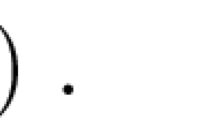Summary
A model for the time evolution of wave packets is developed, in which the gravitational effects of a «particle» on its own wave function are taken into account. Upon suitably combining quantum (wave) mechanics and general relativity, we deal with the stochastic effects, coming from the former, on the space-time metric described by the latter. In turn, the fact that the metric is not well defined affects the evolution of the wave function, then allowing for a «natural» breakdown of the quantum superposition principle for macroscopic systems and helping to clarify the classical limit of quantum mechanics. We also analysed the question of the relevance of these ideas in the everlasting «measurement problem» in quantum mechanics.
Similar content being viewed by others
References
J. L. Sánchez-Gómez andJ. Unturbe: FTUAM preprint, to be published.
[2]E. Joos andD. H. Zee:Z. Phys. B,59, 223 (1985), and references therein.
[3]G. C. Ghirardi, A. Rimini andT. Weber:Phys. Rev. D,36, 3287 (1987).
[4]E. Joos:Phys. Rev. D,36, 3285 (1987).
[5]G. C. Ghirardi, A. Rimini andT. Weber:Phys. Rev. D,34, 470 (1986).
[6]J. S. Bell: inSchrödinger Centenary, edited byC. A. Kilmister (Cambridge University Press, Cambridge, 1987).
[7]F. Károlyházy:Nuovo Cimento A,42, 390 (1966), and Thesis (in Hungarian) (1974).
[8]F. Károlyházy, A. Frenkel andB. Lukács: inQuantum Concepts in Space and Time, edited byR. Penrose andC. Isham (Clarendon, Oxford, 1986); and inPhysics as a Natural Phylosophy. Essays in Honour of Laszlo Tisza, edited byA. Shimony andH. Feshbach (MIT Press, Cambridge, Mass., 1982).
[9]B. S. DeWitt:Phys. Rev.,160, 1113 (1967);J. A. Wheeler: inBattelle Rencontres 1967, edited byC. DeWitt andJ. A. Wheeler (Benjamin, New York, N.Y., 1968).
[10]T. Banks:Nucl. Phys. B,249, 332 (1985). For a review see:E. Alvarez:Rev. Mod. Phys.,61, 561 (1989).
V. A. Fock:The Theory of Space, Time and Gravitation (Pergamon Press, 1969).
[12]E. Schrödinger:Expanding Universes (Cambridge University Press, Cambridge, 1957).
P. Pfeiffer:Chiral Molecules—a Superselection Rule Induced by the Radiation Field, Diss. ETH No. 651 (Zürich, 1980).
[14]L. E. Ballentine:Phys. Rev. A,43, 9 (1991).
[15]L. Diosi:Phys. Rev. A,40, 1165 (1989).
[16]J. Ellis, S. Mohanty andD. Nanopoulos:Phys. Lett. B,221, 113 (1989).
Author information
Authors and Affiliations
Additional information
The authors of this paper have agreed to not receive the proofs for correction.
Rights and permissions
About this article
Cite this article
Unturbe, J., Sánchez-Gómez, J.L. On the role of gravitation in the possible breakdown of the quantum superposition principle for macroscopic systems. Nuov Cim B 107, 211–237 (1992). https://doi.org/10.1007/BF02722918
Received:
Revised:
Published:
Issue Date:
DOI: https://doi.org/10.1007/BF02722918



